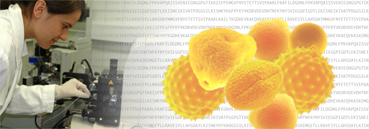Proteomics of Pollen Allergens

After working on biochemistry and molecular biology of the yeast spore wall for many years, our group has recently switched to mass spectrometry and proteomics of allergens.
With the develpoment of modern tandem mass spectrometers, proteomic research became an increasingly important tool to identify and characterize proteins in complex samples. Basically, two complementary approaches are possible. Proteins are extracted from cells or organelles, digested with protease and the resulting peptides are separated by reverse phase HPLC and analyzed by a directly coupled tandem mass spectrometer. The other option is to separate the extracted proteins by one- or two-dimensional gel electrophoresis, digest protein spots with protease and analyze the peptides by MS. Tandem MS instruments are able to simultaneously aquire peptide masses and peptide fragmentation patterns. With this information, proteins can be unequivocally identified in protein data bases. Sequence information obtained for unknown proteins can be used for cloning the corresponding genes. Our group uses a Micromass Global Ultima Q-Tof (quadrupole – time-of-flight ) mass spectrometer with electro spray ionizatiion, optionally coupled with a capillary HPLC.
Using the methodology described above, we try to identify new proteins or protein isoforms that induce type I allergies in allergic patients. Our main focus are allergens from tree (birch and selected trees) and weed (mugwort, ragweed) pollen. Our work is done in close cooperation with the group of Fátima Ferreira.





